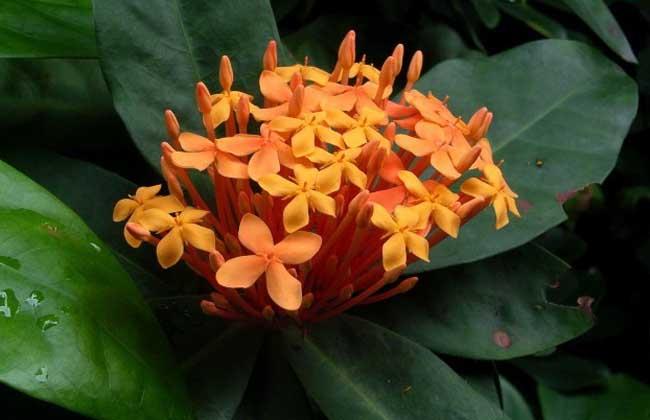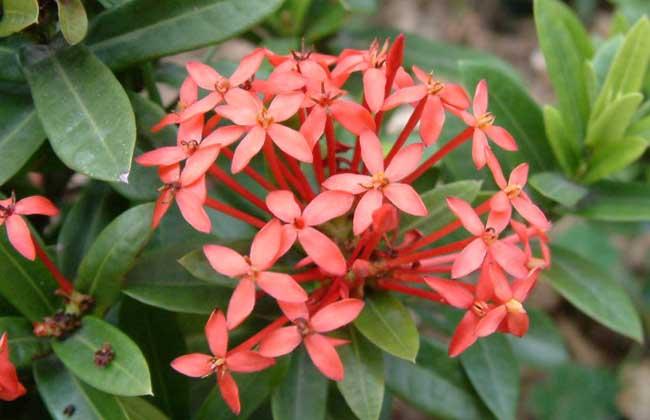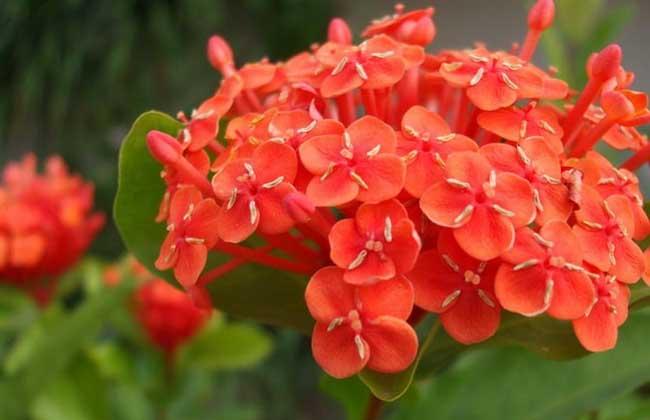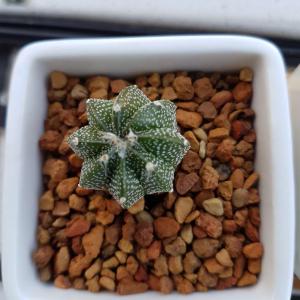文章
Miss Chen
2017年07月18日


Nombre científico o latino: Brugmansia sanguinea
Sinónimo: Datura sanguinea
Nombre común o vulgar: Trompetero rojo.
Familia: Solanaceae.
Origen: Sudamérica.
Arbusto grande o arbolito que alcanza 4-6 m de altura.
Crece rápidamente
Hoja caduca.
Florece de final de verano a principios de otoño.

El color de la flor es la diferencia principal con Brugmasia arborea y otras especies de este género. En este caso es anaranjado-rojizo.
Precaución: todas las partes de la planta son tóxicas si se ingieren. Evitar plantar donde haya niños (chuparse los dedos después del contacto supone un riesgo).
Proteger del frío.
Luz: sol o mejor, semisombra en climas calurosos.
Sustrato: rico, drenado, fresco pero seco en invierno.
Multiplicación: semilla, esqueje semileñoso en verano (en estufa; utilizar hormonas de enraizamiento).
0
0
文章
Miss Chen
2017年07月18日


Nombre científico o latino: Bauhinia galpinii
Sinónimo: Bauhinia punctata
Nombre común o vulgar: Bauhinia roja.
Familia: Caesalpiniaceae (Leguminosae).
Origen: Sudáfrica.
Arbusto grande de 2 a 4 m de altura.
Porte: abierto, arbustivo o semitrepadora.
Crecimiento: rápido.

Hoja perenne.
Flores color rojo-naranja en verano.
Luz: sol o semisombra.
Es planta bastante resistente, soportando suelos pobres y secos.
Sustrato: cualquiera bien drenado, más bien fresco (aunque soporta cortos periodos de sequía), contenido en nutrientes medio-alto; ácido, neutro o alcalino.
Poda muy ligera de limpieza a final de invierno.
Puede sufrir clorosis por carencia de hierro en suelos calizos.
Multiplicación: por semillas en primavera (fácil, germinan bien) y por esqueje en verano (difícil).
0
0
文章
Colour_
2017年07月17日

红宝石的养殖技巧

土壤:
红宝石的土壤可以采用煤渣混合泥炭、少量珍珠岩,比例大概5:4:1。
光照:
红宝石需要全日照,红宝石的叶片向内凹陷有明显的波折,强光下或者温差大,叶片会泛红。弱光则叶色会变成绿色,叶片拉长,颜色也变的有点浅绿。红宝石叶面光滑,不容易积水。叶片微白粉,红宝石需要接受充足日照叶色才会艳丽,株型才会更紧实美观。
温度及浇水:
红宝石生长期需保持土壤湿润,避免积水。红宝石能耐零下4℃左右的低温,是室内的温度,非露天,再低叶片的顶端生长点就会出现冻伤,干枯死亡,整个冬季基本断水,5度以下就要开始慢慢断水。夏季高温时整个植株生长缓慢或完全停止,这个时候要通风良好且适当遮光,避免曝晒,节制浇水,不能长期雨淋,以免植株腐烂。
红宝石的养护方法
红宝石需要阳光充足和凉爽、干燥的环境,耐半阴,怕水涝,忌闷热潮湿。具有冷凉季节生长,夏季高温休眠的习性。每年的9月至第二年的6月为植株的生长期,若光照不足会使植株叶片徒长,叶片颜色也会变成绿色;而在阳光充足之处生长的植株,株型矮壮,叶片排列会紧凑。
多肉植物红宝石怎么种养,红宝石的养殖养护方法,小编就给大家介绍到这了。红宝石群生后,植株会非常壮观,特别是多年修剪过的老桩。红宝石簇状花序花色红粉色,和大多数的石莲花一样的花型。

红宝石病虫害防治
红蜘蛛:一般因空气干燥所引起的 ,用一些杀螨类药剂防治:用2000倍克螨特,1500倍三氯杀螨乙醇防治。
蓟马:秋冬季节蓟马危害比较严重,先由蓟马危害,在叶片上产生一点、一点的伤口,然后伤口引起病菌感染,产生病斑。所以生产上注意对蓟马进行防治。可用啶虫咪1500倍或万灵3000倍进行防治。
红宝石观赏价值
叶柄长而粗壮,气生根极发达粗壮,纷然披垂,将其布置室内,大方清雅,富热带雨林气氛。是好的观叶植物,现在我国中南部各省广泛栽培。

土壤:
红宝石的土壤可以采用煤渣混合泥炭、少量珍珠岩,比例大概5:4:1。
光照:
红宝石需要全日照,红宝石的叶片向内凹陷有明显的波折,强光下或者温差大,叶片会泛红。弱光则叶色会变成绿色,叶片拉长,颜色也变的有点浅绿。红宝石叶面光滑,不容易积水。叶片微白粉,红宝石需要接受充足日照叶色才会艳丽,株型才会更紧实美观。
温度及浇水:
红宝石生长期需保持土壤湿润,避免积水。红宝石能耐零下4℃左右的低温,是室内的温度,非露天,再低叶片的顶端生长点就会出现冻伤,干枯死亡,整个冬季基本断水,5度以下就要开始慢慢断水。夏季高温时整个植株生长缓慢或完全停止,这个时候要通风良好且适当遮光,避免曝晒,节制浇水,不能长期雨淋,以免植株腐烂。
红宝石的养护方法
红宝石需要阳光充足和凉爽、干燥的环境,耐半阴,怕水涝,忌闷热潮湿。具有冷凉季节生长,夏季高温休眠的习性。每年的9月至第二年的6月为植株的生长期,若光照不足会使植株叶片徒长,叶片颜色也会变成绿色;而在阳光充足之处生长的植株,株型矮壮,叶片排列会紧凑。
多肉植物红宝石怎么种养,红宝石的养殖养护方法,小编就给大家介绍到这了。红宝石群生后,植株会非常壮观,特别是多年修剪过的老桩。红宝石簇状花序花色红粉色,和大多数的石莲花一样的花型。

红宝石病虫害防治
红蜘蛛:一般因空气干燥所引起的 ,用一些杀螨类药剂防治:用2000倍克螨特,1500倍三氯杀螨乙醇防治。
蓟马:秋冬季节蓟马危害比较严重,先由蓟马危害,在叶片上产生一点、一点的伤口,然后伤口引起病菌感染,产生病斑。所以生产上注意对蓟马进行防治。可用啶虫咪1500倍或万灵3000倍进行防治。
红宝石观赏价值
叶柄长而粗壮,气生根极发达粗壮,纷然披垂,将其布置室内,大方清雅,富热带雨林气氛。是好的观叶植物,现在我国中南部各省广泛栽培。
2
6
文章
Colour_
2017年07月17日


刺梅的养殖方法
施肥
肥料一般少给,春季、冬季可以少量施肥。虎刺梅生长期一般3~4周施1次稀释过的肥料即可。施肥过多会造成枝叶过于的生长旺盛,而光长叶子不开花,观赏性受到破坏,而在他们打花苞时期可以少量施肥,这样不仅叶繁而且花茂盛。
光照
我们都知道一般植物都是要光照充足才能够长得茂盛,而虎刺梅也是一样,最好是一年光照充足,开花期间尤为要注意,由于是养在室内,所以我们需经常把虎刺梅搬到能够受到光照的地方,阳光充足了,花色彩鲜艳,叶片才茂盛。若长期放在阴暗的环境下,长势就不好,因为这种植物他是喜温不耐寒的。
修剪
虎刺梅的花开在新枝的顶端,要想让虎刺梅多开花,就必须进行适当的修剪。而修建的季节和手法也是需要注意的,千万不要选在开花季修建,而且要需要注意的是主枝,因为主枝太长,开花就少。所以应在花期之后将过长的和生长不整齐的枝剪短,一般这样在下次开花的时候就能够保证花的数量和长势了,修建一般在枝条的剪口下长出2个新枝,当新枝长到5~6厘米时就能开花。几年后,整个植株就会开满鲜艳的小红花。
架支
由于枝条细长较软,随植株长大,主枝承受不了重量容易弯曲,所以这个时候你要就可用竹棍或铁丝扎成不同形状的支架,将枝条牵引捆缚其上,使之成为花柱状,这样一来能够保证虎刺梅的生长,还能与之造型,增添美感。如果你不管,任其自然生长,其主枝就会越长越长,不仅开花少,而且株形也不美观。还容易则断。

刺梅的养殖注意事项
刺梅病虫害较少,苗期常见的病害主要有炭疽病、白粉病、锈病等。虫害主要有蛴螬、金针虫等。可采用深翻土壤,改善苗圃卫生条件的方法,减少病虫源。
0
1
文章
Dummer. ゛☀
2017年07月17日

Family - Apiaceae
Stems - To 60cm tall, from weak roots, erect, herbaceous, glabrous, rounded to slightly 4-angled, simple or with few branches.
Leaves - Alternate, petiolate, pinnately divided, glabrous, to 5cm long. Petioles to 4-5mm long, sheathing and flattened. Leaflets opposite, lowest pair often divided again (bifurcate), all leaflets filiform.
Inflorescence - Terminal compound umbels. Primary rays of umbels typically 8-11, to 9mm long in flower, longer in fruit, glabrous, subtended by 3-15 unequal threadlike bracts (to +1cm long), glabrous. Umbellets of typically 5-11 flowers. Raylets to 3mm long in flower, longer in fruit, glabrous, subtended by few short threadlike bracts.
Flowers - Petals 5, white, equal, to +/-1.3mm long, 1mm broad, glabrous, apiculate to caudate and incurved at apex. Stamens 5, alternating with petals. Filaments white, .8mm long, glabrous. Anthers pinkish-rose, +/-.3mm long. Styles 2, short, with broad expanded stylopodium. Ovary inferior, 2-locular, with one ovule per locule. Sepals 5, alternating with petals, whitish, triangular-attenuate, .3mm long. Fruits 2.4mm broad, glabrous, ovoid to orbicular, with persistent sepals and styles.
Flowering - June - August.
Habitat - Moist to wet prairies, swampy meadows, wet depressions of glades, wet ground along railroads.
Origin - Native to U.S.
Other info. - This species is small but easy to ID in the field because of its very fine leaves, weak stems, and large umbels of flowers. It grows in moist locations which is another major factor used in identification. The plant can be found in large numbers in some areas, such as prairies.
Photographs taken at the Dorris Creek Prairie Conservation Area, Barton County, MO., 7-28-00, and at Bethel Prairie, Barton County, MO., 7-4-03.
Stems - To 60cm tall, from weak roots, erect, herbaceous, glabrous, rounded to slightly 4-angled, simple or with few branches.

Leaves - Alternate, petiolate, pinnately divided, glabrous, to 5cm long. Petioles to 4-5mm long, sheathing and flattened. Leaflets opposite, lowest pair often divided again (bifurcate), all leaflets filiform.
Inflorescence - Terminal compound umbels. Primary rays of umbels typically 8-11, to 9mm long in flower, longer in fruit, glabrous, subtended by 3-15 unequal threadlike bracts (to +1cm long), glabrous. Umbellets of typically 5-11 flowers. Raylets to 3mm long in flower, longer in fruit, glabrous, subtended by few short threadlike bracts.

Flowers - Petals 5, white, equal, to +/-1.3mm long, 1mm broad, glabrous, apiculate to caudate and incurved at apex. Stamens 5, alternating with petals. Filaments white, .8mm long, glabrous. Anthers pinkish-rose, +/-.3mm long. Styles 2, short, with broad expanded stylopodium. Ovary inferior, 2-locular, with one ovule per locule. Sepals 5, alternating with petals, whitish, triangular-attenuate, .3mm long. Fruits 2.4mm broad, glabrous, ovoid to orbicular, with persistent sepals and styles.

Flowering - June - August.
Habitat - Moist to wet prairies, swampy meadows, wet depressions of glades, wet ground along railroads.
Origin - Native to U.S.
Other info. - This species is small but easy to ID in the field because of its very fine leaves, weak stems, and large umbels of flowers. It grows in moist locations which is another major factor used in identification. The plant can be found in large numbers in some areas, such as prairies.
Photographs taken at the Dorris Creek Prairie Conservation Area, Barton County, MO., 7-28-00, and at Bethel Prairie, Barton County, MO., 7-4-03.
0
0
文章
Dummer. ゛☀
2017年07月17日

Family - Polygonaceae
Stems - To +/-1m Long, erect to clambering, simple, 4-angled, hollow, becoming pinkish-red in full sun, with retrorse prickles on angles, from fibrous roots. Nodes sometimes slightly swollen.
Leaves - Alternate, petiolate. Ocrea one-sided, sheathing the stem on opposite side from leaf, to 7-8mm long, glabrous. Petiole connected at base of ocrea, to +/-1.2cm long, with retrorse barbs. Blades sagittate, +/-5cm long, +/-1.5cm broad, entire, with slightly revolute margins (the margins antrorse ciliate), glabrous above and below except for retrorse prickles on midrib below. Auricles acute, 7-8mm long.
Inflorescence - Terminal and axillary capitate cluster of 1-10 flowers. Peduncles glabrous. Bracts subtending flowers with scarious margins. Pedicels to 2mm long.
Flowers - Perianth segments white to pinkish, glabrous, 3mm long. Stamens +/-8, erect. Filaments white, to 1.4mm long, some adnate to perianth segments. Anthers white, .2mm long. Achenes 3-sided, glabrous, chocolate to black, to 2.5mm long.
Flowering - June - September.
Habitat - Wet places, roadsides, railroads.
Origin - Native to U.S.
Other info. - This is a simple species to ID in the field because of its square, prickly stems and its sagittate leaves. The plant likes moist areas such as fens or pond margins. The flowers are small and not showy but are not needed to help ID the plant. This species is found nearly throughout Missouri but has not been recorded in some Ozark counties. Our plants belong to variety sagittatum. Another variety, var. gacilenta Fern., has few to no prickles on the stem. This latter variety is not found in Missouri but in a few states to our east.
Stems - To +/-1m Long, erect to clambering, simple, 4-angled, hollow, becoming pinkish-red in full sun, with retrorse prickles on angles, from fibrous roots. Nodes sometimes slightly swollen.
Leaves - Alternate, petiolate. Ocrea one-sided, sheathing the stem on opposite side from leaf, to 7-8mm long, glabrous. Petiole connected at base of ocrea, to +/-1.2cm long, with retrorse barbs. Blades sagittate, +/-5cm long, +/-1.5cm broad, entire, with slightly revolute margins (the margins antrorse ciliate), glabrous above and below except for retrorse prickles on midrib below. Auricles acute, 7-8mm long.

Inflorescence - Terminal and axillary capitate cluster of 1-10 flowers. Peduncles glabrous. Bracts subtending flowers with scarious margins. Pedicels to 2mm long.

Flowers - Perianth segments white to pinkish, glabrous, 3mm long. Stamens +/-8, erect. Filaments white, to 1.4mm long, some adnate to perianth segments. Anthers white, .2mm long. Achenes 3-sided, glabrous, chocolate to black, to 2.5mm long.

Flowering - June - September.
Habitat - Wet places, roadsides, railroads.
Origin - Native to U.S.
Other info. - This is a simple species to ID in the field because of its square, prickly stems and its sagittate leaves. The plant likes moist areas such as fens or pond margins. The flowers are small and not showy but are not needed to help ID the plant. This species is found nearly throughout Missouri but has not been recorded in some Ozark counties. Our plants belong to variety sagittatum. Another variety, var. gacilenta Fern., has few to no prickles on the stem. This latter variety is not found in Missouri but in a few states to our east.
0
0
文章
Dummer. ゛☀
2017年07月17日

Family - Phytolaccaceae
Stems - To 3m tall, erect, glabrous, greenish to purple-red, branching, herbaceous.
Leaves - Alternate, entire, oblong, lanceolate-oblong, or ovate, petiolate, up to +30cm long, +15cm wide.
Inflorescence - Axillary racemes to +/-40cm long. Pedicels to 1cm long, 4-angled, tuberculate on angles, subtended by curling bract. Bract to 4mm long, 1mm broad. Pedicel with two small attenuate bracts alternate about at it's midpoint. Axis of inflorescence and pedicels whitish in flower, becoming red in fruit.
Flowers - Apetalous. Sepals 5, white or with a pinkish tinge, distinct, 2.2mm long and broad, slightly involute, broadly ovate to rotund, entire or slightly erose near apex. Stamens 10. Filaments pinkish-white, 2mm long, glabrous. Ovary 10-carpellate, green, globose to subglobose, 2.4mm in diameter, glabrous. Fruit a purple-black berry to -1cm in diameter.
Flowering - May - October.
Habitat - Waste ground, disturbed sites, open woods, pastures, prairies, roadsides, railroads.
Origin - Native to U.S.
Other info. - All parts of this weedy species are toxic when mature but the young shoots and leaves can be eaten when cooked. Why take the chance when there is a grocery store on every corner? The "ink" from the berries will stain almost anything it touches.
This is an easy species to ID in the field because of its big, alternate leaves, reddish stems, long inflorescences, and purple berries.
Stems - To 3m tall, erect, glabrous, greenish to purple-red, branching, herbaceous.

Leaves - Alternate, entire, oblong, lanceolate-oblong, or ovate, petiolate, up to +30cm long, +15cm wide.
Inflorescence - Axillary racemes to +/-40cm long. Pedicels to 1cm long, 4-angled, tuberculate on angles, subtended by curling bract. Bract to 4mm long, 1mm broad. Pedicel with two small attenuate bracts alternate about at it's midpoint. Axis of inflorescence and pedicels whitish in flower, becoming red in fruit.

Flowers - Apetalous. Sepals 5, white or with a pinkish tinge, distinct, 2.2mm long and broad, slightly involute, broadly ovate to rotund, entire or slightly erose near apex. Stamens 10. Filaments pinkish-white, 2mm long, glabrous. Ovary 10-carpellate, green, globose to subglobose, 2.4mm in diameter, glabrous. Fruit a purple-black berry to -1cm in diameter.

Flowering - May - October.
Habitat - Waste ground, disturbed sites, open woods, pastures, prairies, roadsides, railroads.
Origin - Native to U.S.
Other info. - All parts of this weedy species are toxic when mature but the young shoots and leaves can be eaten when cooked. Why take the chance when there is a grocery store on every corner? The "ink" from the berries will stain almost anything it touches.
This is an easy species to ID in the field because of its big, alternate leaves, reddish stems, long inflorescences, and purple berries.
0
0
文章
Dummer. ゛☀
2017年07月16日

Family - Fabaceae
Stems - To +2m tall, herbaceous, erect, branching, typically single from base, glabrous or with a few sparse hairs.

Leaves - Alternate, trifoliolate, stipulate. Stipules linear-attenuate, 4-5mm long, -1mm broad, glabrous. Petioles to +/-1cm long, glabrous or with a few sparse hairs, with an adaxial groove. Petiolules to 2mm long on lateral leaflets and 5-6mm long on terminal leaflet. Leaflets subequal (the terminal slightly larger), oblong to oblong-oblanceolate, serrate-dentate, glabrous, to +/-3cm long, +/-1cm broad.
Inflorescence - Axillary pedunculate racemes to +/-8cm long(tall) in flower, longer in fruit. Axis sparsely pubescent. Each pedicel subtended by a linear-attenuate bract to 1mm long. Pedicels to 1.1mm long, mostly glabrous.

Flowers - Corolla white, papilionaceous, glabrous. Standard to 4mm long. The keel petals apically connate. The wing petals basally adnate to the keels, with basal auricles to .5mm long. Stamens diadelphous, white, glabrous. Anthers yellow, .2mm long. Style glabrous, +/-2mm long. Ovary green, glabrous, 1.1mm long. Fruits to 4-5mm long, inflated, with a short beak, glabrous, green. Calyx weakly bilabiate. Calyx tube green, to 1mm long, sparsely pubescent to glabrous. The upper lip 2-lobed. Lobes triangular-acuminate, 1mm long. The lower lip 3-lobed. The lobes slightly larger to equaling those of the upper lip.Flowering - May - October.

Habitat - Disturbed sites, waste ground, roadsides, railroads.
Origin - Native to Eurasia.
Other info. - This plant is extremely common and is very invasive. It was and is used for fodder because if its protein content. The plant has an undesirable smell (at least to me) when crushed or cut. Many people have reported headaches after being exposed to the smell of the freshly cut plants for too long. Some people become noxious from the smell. Plants from the genus Melilotus contain coumarins, which are used to make rat poisons.
This plant is very similar to M. officinalis but that species starts blooming a few weeks to a month earlier and has yellow flowers.
Stems - To +2m tall, herbaceous, erect, branching, typically single from base, glabrous or with a few sparse hairs.

Leaves - Alternate, trifoliolate, stipulate. Stipules linear-attenuate, 4-5mm long, -1mm broad, glabrous. Petioles to +/-1cm long, glabrous or with a few sparse hairs, with an adaxial groove. Petiolules to 2mm long on lateral leaflets and 5-6mm long on terminal leaflet. Leaflets subequal (the terminal slightly larger), oblong to oblong-oblanceolate, serrate-dentate, glabrous, to +/-3cm long, +/-1cm broad.
Inflorescence - Axillary pedunculate racemes to +/-8cm long(tall) in flower, longer in fruit. Axis sparsely pubescent. Each pedicel subtended by a linear-attenuate bract to 1mm long. Pedicels to 1.1mm long, mostly glabrous.

Flowers - Corolla white, papilionaceous, glabrous. Standard to 4mm long. The keel petals apically connate. The wing petals basally adnate to the keels, with basal auricles to .5mm long. Stamens diadelphous, white, glabrous. Anthers yellow, .2mm long. Style glabrous, +/-2mm long. Ovary green, glabrous, 1.1mm long. Fruits to 4-5mm long, inflated, with a short beak, glabrous, green. Calyx weakly bilabiate. Calyx tube green, to 1mm long, sparsely pubescent to glabrous. The upper lip 2-lobed. Lobes triangular-acuminate, 1mm long. The lower lip 3-lobed. The lobes slightly larger to equaling those of the upper lip.Flowering - May - October.

Habitat - Disturbed sites, waste ground, roadsides, railroads.
Origin - Native to Eurasia.
Other info. - This plant is extremely common and is very invasive. It was and is used for fodder because if its protein content. The plant has an undesirable smell (at least to me) when crushed or cut. Many people have reported headaches after being exposed to the smell of the freshly cut plants for too long. Some people become noxious from the smell. Plants from the genus Melilotus contain coumarins, which are used to make rat poisons.
This plant is very similar to M. officinalis but that species starts blooming a few weeks to a month earlier and has yellow flowers.
0
0
文章
Dummer. ゛☀
2017年07月16日

Family - Campanulaceae
Stems - Simple, erect, to +/-50cm tall, glabrous to variously pubescent, herbaceous, 4-5 angled.
Leaves - Mostly in lower 1/2 of stem, sessile or short petiolate (near base of stem), spatulate to oblong, rounded at apex, entire to irregularly dentate (margins strigillose to ciliate), +/-5cm long, +/-2cm broad, sparse strigose to glabrous.
Inflorescence - Terminal spikiform raceme to +/-35cm long (tall). Each flower subtended by a lance-linear to subulate bract to 1.5cm long, 3mm broad. Bracts typically glabrous. Pedicels to 3mm long, glabrous to pubescent.
Flowers - Resupinate. Corolla whitish to lilac, to 1.3mm long, 5-lobed. Three "upper" lobes to 4.1mm long, 2mm broad, oblanceolate to lanceolate. Two "lower" lobes deflexed to reflexed, 3mm long. Stamens 5, adnate at base of corolla tube. Filaments white, pubescent at base. Anthers purplish-blue, connate around stigma. Stigma purple, bearded at base. Style 1, 5mm long, glabrous, greenish. Ovary ovoid-conic, slightly compressed, green, 2-locular. Placentation axile. Calyx tube +/-1mm long, 5-lobed. Lobes auricled at base, 3mm long, -1mm broad at base, linear-attenuate. Auricles various. Capsule to 8mm long, +/-4mm in diameter, glabrous to pubescent.
Flowering - May - August.
Habitat - Prairies, glades, open woods, bluffs, wet meadows.
Origin - Native to U.S.
Other info. - This is a highly variable species. The flowers can be bluish to white, the stems can be glabrous to hispid, and the calyx lobes can have variable auricles at their bases. The anthers of the plant can also be variable in color sometimes. Steyermark breaks the species apart into 4 different varieties but these varieties integrade and can be difficult to distinguish so I won't mention them here.
Remember, the flowers are inverted (resupinate) on this plant so what looks like the top of the flower is actually the bottom and vice-versa.
Stems - Simple, erect, to +/-50cm tall, glabrous to variously pubescent, herbaceous, 4-5 angled.

Leaves - Mostly in lower 1/2 of stem, sessile or short petiolate (near base of stem), spatulate to oblong, rounded at apex, entire to irregularly dentate (margins strigillose to ciliate), +/-5cm long, +/-2cm broad, sparse strigose to glabrous.
Inflorescence - Terminal spikiform raceme to +/-35cm long (tall). Each flower subtended by a lance-linear to subulate bract to 1.5cm long, 3mm broad. Bracts typically glabrous. Pedicels to 3mm long, glabrous to pubescent.

Flowers - Resupinate. Corolla whitish to lilac, to 1.3mm long, 5-lobed. Three "upper" lobes to 4.1mm long, 2mm broad, oblanceolate to lanceolate. Two "lower" lobes deflexed to reflexed, 3mm long. Stamens 5, adnate at base of corolla tube. Filaments white, pubescent at base. Anthers purplish-blue, connate around stigma. Stigma purple, bearded at base. Style 1, 5mm long, glabrous, greenish. Ovary ovoid-conic, slightly compressed, green, 2-locular. Placentation axile. Calyx tube +/-1mm long, 5-lobed. Lobes auricled at base, 3mm long, -1mm broad at base, linear-attenuate. Auricles various. Capsule to 8mm long, +/-4mm in diameter, glabrous to pubescent.

Flowering - May - August.
Habitat - Prairies, glades, open woods, bluffs, wet meadows.
Origin - Native to U.S.
Other info. - This is a highly variable species. The flowers can be bluish to white, the stems can be glabrous to hispid, and the calyx lobes can have variable auricles at their bases. The anthers of the plant can also be variable in color sometimes. Steyermark breaks the species apart into 4 different varieties but these varieties integrade and can be difficult to distinguish so I won't mention them here.
Remember, the flowers are inverted (resupinate) on this plant so what looks like the top of the flower is actually the bottom and vice-versa.
0
0
文章
Miss Chen
2017年07月16日


#仙丹花 别称山丹花、龙船花、矮仙丹等,为茜草科仙丹花属常绿灌木植物,全年均能开花,但以夏、秋较盛开,花顶生,花瓣4枚,聚生成团,花姿娇艳,耐旱耐高温,生性强健,适合庭园美化和盆栽等,下面我们就一起来看一看仙丹花的养殖方法吧!

仙丹花的生长习性
仙丹花较适合高温及日照充足的环境,喜湿润炎热的气候,不耐低温。生长适温在23~32℃,当气温低于20℃度后其长势减弱,开花明显减少,但若日照充足,仍有一定数量的花苞。当温度低于10℃后,其生理活性降低,生长缓慢。当温度低于0℃时,会产生冻害。喜酸性土壤,最适合的土壤pH值为5~5.5。排水良好、保肥性能好的土壤即可生长良好。

仙丹花的繁殖方法
1、扦插:仙丹花扦插繁殖以6~7月进行为好,选取半成熟枝条,长10~15厘米,插入沙床,适温为24~30℃,插后40~50天生根。
2、播种:仙丹花冬季采种,春季播种。发芽适温为22~24℃,播后20~25天发芽,长出3~4对真叶时可移苗于8厘米盆。
3、压条:仙丹花分枝多而密集的植株在离顶端20厘米处行环状剥皮,用泥炭和薄膜包扎,2个多月可愈合生根。

仙丹花的养殖方法
1、土壤:仙丹花养殖土壤以肥沃、疏松和排水良好的酸性砂质壤土为佳,盆栽用培养土、泥炭土和粗沙的混合土壤,pH在5~5.5为宜。
2、浇水:仙丹花喜湿怕干,保持盆土湿润有利于枝梢萌发和叶片生长。但长期过于湿润,容易引起部分根系腐烂,影响生长和开花。
3、阳光:仙丹花需阳光充足,充足的阳光下,叶片翠绿有光泽,有利于花序形成,开花整齐且鲜艳,夏季强光时适当遮荫可延长观花期。
4、温度:仙丹花的生长适温为15~25℃,3~9月为24~30℃,9月至翌年3月为13~18℃。冬季温度不低0℃,过低易遭受冻害。
5、施肥:仙丹花生长期每半个月施1次用氮、磷、钾、硫酸亚铁和马蹄片按1:1:1:2:3比例混合加水经腐熟发酵后的液肥。
6、修剪:仙丹花修剪多在春季出室后进行,主要是对植株进行适当疏枝,以利通风通光。另外,花期适当摘心,可使其多孕蕾、开花。
7、虫害:仙丹花常有叶斑病和炭疽病危害,可用10%抗菌剂401醋酸溶液1000倍液喷洒。虫害有介壳虫危害,可用40%氧化乐果乳油1500倍液喷杀。
0
1
文章
Dummer. ゛☀
2017年07月14日

Family - Convolvulaceae
Stems - Trailing, twining, herbaceous, glabrous to pubescent, appearing 4-5 angled because of twisting of stem.
Leaves - Alternate, petiolate, variable in shape from ovate to elliptic, to 10cm long, +/-5cm broad, hastate to sagittate or cordate. Petiole to +3cm long, with adaxial groove, pubescent to glabrous. Blade glabrous or pubescent. Basal lobes acute to obtuse. Leaf margins often undulate.
Inflorescence - Flowers either single or in loose cymes of up to 3 flowers. Peduncle to +6cm long, with opposite to subopposite pair of bracts at apex(subtending pedicels), pubescent. Bracts to +4mm long. Pedicels to -2cm long, with pair of opposite to subopposite bracts in middle, pubescent to tomentose. Bracts to +/-3mm long, linear.
Flowers - Corolla funnelform, white or tinged with pink, to +/-3cm broad, -2cm long, glabrous internally, glabrous to sparse puberulent externally. Stamens 5, adnate at base of corolla tube. Filaments to 1cm long, flattened and broad at base(to 1.2mm broad), terete above, clavate pubescent near base, white. Anthers whitish-pink, to 3mm long. Style white, glabrous, 1cm long. Stigmas 2, 3-4mm long, white to pale yellow. Ovary subtended(surrounded) by orange nectar ring. Ovary white, glabrous to pubescent, superior, 2mm long, 2-locular. Sepals 5, green and often with tiny brownish tip, glabrous, 4mm long, 2.1mm broad, scarious near apex, distinct. Fruit a glabrous 4-valved capsule to +/-6mm long.
Flowering - May - September.
Habitat - Waste ground, disturbed sites, roadsides, railroads.
Origin - Native to Europe and Asia.
Other info. - According to Steyermark there are two forms in Missouri. Form arvensis (pictured above) has lobes at the base of the leaves being pointed (acutely), the leaf blade itself can be from sagittate to ovate-triangular. Form cordifolius has lobes which are rounded and a broad cordate leaf blade.
This species is quite common and weedy. It primarily stays low or on the ground but can climb by twining. The species name "arvensis" means "from cultivated fields" or "of cultivated fields" telling of the plants pioneering and invasive nature.
The pubescence of the plant is highly variable.
Stems - Trailing, twining, herbaceous, glabrous to pubescent, appearing 4-5 angled because of twisting of stem.

Leaves - Alternate, petiolate, variable in shape from ovate to elliptic, to 10cm long, +/-5cm broad, hastate to sagittate or cordate. Petiole to +3cm long, with adaxial groove, pubescent to glabrous. Blade glabrous or pubescent. Basal lobes acute to obtuse. Leaf margins often undulate.
Inflorescence - Flowers either single or in loose cymes of up to 3 flowers. Peduncle to +6cm long, with opposite to subopposite pair of bracts at apex(subtending pedicels), pubescent. Bracts to +4mm long. Pedicels to -2cm long, with pair of opposite to subopposite bracts in middle, pubescent to tomentose. Bracts to +/-3mm long, linear.

Flowers - Corolla funnelform, white or tinged with pink, to +/-3cm broad, -2cm long, glabrous internally, glabrous to sparse puberulent externally. Stamens 5, adnate at base of corolla tube. Filaments to 1cm long, flattened and broad at base(to 1.2mm broad), terete above, clavate pubescent near base, white. Anthers whitish-pink, to 3mm long. Style white, glabrous, 1cm long. Stigmas 2, 3-4mm long, white to pale yellow. Ovary subtended(surrounded) by orange nectar ring. Ovary white, glabrous to pubescent, superior, 2mm long, 2-locular. Sepals 5, green and often with tiny brownish tip, glabrous, 4mm long, 2.1mm broad, scarious near apex, distinct. Fruit a glabrous 4-valved capsule to +/-6mm long.
Flowering - May - September.

Habitat - Waste ground, disturbed sites, roadsides, railroads.
Origin - Native to Europe and Asia.
Other info. - According to Steyermark there are two forms in Missouri. Form arvensis (pictured above) has lobes at the base of the leaves being pointed (acutely), the leaf blade itself can be from sagittate to ovate-triangular. Form cordifolius has lobes which are rounded and a broad cordate leaf blade.
This species is quite common and weedy. It primarily stays low or on the ground but can climb by twining. The species name "arvensis" means "from cultivated fields" or "of cultivated fields" telling of the plants pioneering and invasive nature.
The pubescence of the plant is highly variable.
0
0
文章
我家狗狗会尖叫
2017年07月13日

播种
在3月底4月初温室里进行第一批育苗,由于杂交制种,此时可先播母本和一期父本,待一个月后再播二期父本,这样可保证后期授粉质量。把准备好的床土首先进行土壤消毒,可用高锰酸钾、福尔马林、敌克松等,配成适当比例的水溶液喷洒苗床。床土经过细筛筛过,床平整好,浇足底水,待水渗下后,将种子均匀地撒播在苗床上,种子每克750粒,播前最好做一下催芽处理。种子撒播完毕后,把准备好的砂性土均匀筛在苗床上,覆土厚度为0.3㎝,然后用塑料薄膜、拱棚式覆盖,约经7—10日即能发芽成苗。

苗期管理
待苗长出后,要精心管理,这时温室温度较高,注意控水,避免小苗徒长。当苗长到6—7㎝高时进行移栽,可移栽营养钵内,当苗长到10㎝时,可直接定植在制种棚内,整个制种在保护地塑料大棚内进行。定植前施足底肥,肥料使用N、P、K复合肥为好,株行距按30×30㎝进行栽植,在栽植方式上采用高畦栽植,这样有利于排水、通风透气,避免病虫害发生。栽植地一亩可植6000株苗,父母本比例为1:2较合适,这样即有丰足的产量,又能合理地利用父本花。定植后,要注意浇水、施肥、通风、病虫害的防治等管理。浇水根据苗期的不同,浇水量也不同,视土壤情况而定。定植后一个月开始追肥,少量施复合肥,农家肥更佳,保证苗期茁状成长,福禄考苗期易感染,猝倒病、根腐病等。为避免病虫害发生,一周打一次药,多以防真菌感染病害,通常使用波尔多液、多菌灵、百菌清等。3杂交授粉首先去雄,由于福禄考为两性花,避免母本自花授粉,在母本柱头未开裂前,将雄蕊全部摘除掉。授粉方式有两种:一种为取来父本花,用小镊子将5个花粉粒,分别放到4—5个雌蕊柱上,这样较费人工,但结籽率较好,产量较高,亩产可达6公斤以上。另一种授粉方法为筒授法,必须在父本散粉的条件下,边去雄授粉,在柱头未开裂去掉花冠,剩下花的基部全筒状(花筒)将有粉部分露出。用有粉部分接触柱头,进行授粉,这种方法较省人工,结实率高,速度快,但产量较一前种低一些。杂交时期避免温度过高,超过30℃则影响座果及种子含量,授粉时间整天都可进行,花粉量充足,授粉后可于花朵上摘去一片萼片,以做日后采收种子时之识别。4种子采收专人负责及时采收,在花朵经困杂交后约4—5周便可采收种子。掉落地上的种子,宁可舍去,以免混杂。种子采收后标上品种名称,装种子的容器必须干净,晒种时各品种应间隔一定距离,以免被风吹动而混杂。把采收种置于阴凉处凉晒。
播种育苗
播种育苗:种子较小,每克约550-600粒。可以直播于育苗盘,采用轻质的播种介质。播种后略盖土,常采用细粒蛭石,有助于保持湿润,同时喷洒杀菌剂防止小苗得病。最佳的发芽温度为20-22℃,土温对种子发芽的影响很大,应加倍控制。一般7-14天可以出苗。特别注意小苗不耐移植。播种育苗的时间因地而异。北方地区可以在2月初播种,5月以后开花。
在3月底4月初温室里进行第一批育苗,由于杂交制种,此时可先播母本和一期父本,待一个月后再播二期父本,这样可保证后期授粉质量。把准备好的床土首先进行土壤消毒,可用高锰酸钾、福尔马林、敌克松等,配成适当比例的水溶液喷洒苗床。床土经过细筛筛过,床平整好,浇足底水,待水渗下后,将种子均匀地撒播在苗床上,种子每克750粒,播前最好做一下催芽处理。种子撒播完毕后,把准备好的砂性土均匀筛在苗床上,覆土厚度为0.3㎝,然后用塑料薄膜、拱棚式覆盖,约经7—10日即能发芽成苗。

苗期管理
待苗长出后,要精心管理,这时温室温度较高,注意控水,避免小苗徒长。当苗长到6—7㎝高时进行移栽,可移栽营养钵内,当苗长到10㎝时,可直接定植在制种棚内,整个制种在保护地塑料大棚内进行。定植前施足底肥,肥料使用N、P、K复合肥为好,株行距按30×30㎝进行栽植,在栽植方式上采用高畦栽植,这样有利于排水、通风透气,避免病虫害发生。栽植地一亩可植6000株苗,父母本比例为1:2较合适,这样即有丰足的产量,又能合理地利用父本花。定植后,要注意浇水、施肥、通风、病虫害的防治等管理。浇水根据苗期的不同,浇水量也不同,视土壤情况而定。定植后一个月开始追肥,少量施复合肥,农家肥更佳,保证苗期茁状成长,福禄考苗期易感染,猝倒病、根腐病等。为避免病虫害发生,一周打一次药,多以防真菌感染病害,通常使用波尔多液、多菌灵、百菌清等。3杂交授粉首先去雄,由于福禄考为两性花,避免母本自花授粉,在母本柱头未开裂前,将雄蕊全部摘除掉。授粉方式有两种:一种为取来父本花,用小镊子将5个花粉粒,分别放到4—5个雌蕊柱上,这样较费人工,但结籽率较好,产量较高,亩产可达6公斤以上。另一种授粉方法为筒授法,必须在父本散粉的条件下,边去雄授粉,在柱头未开裂去掉花冠,剩下花的基部全筒状(花筒)将有粉部分露出。用有粉部分接触柱头,进行授粉,这种方法较省人工,结实率高,速度快,但产量较一前种低一些。杂交时期避免温度过高,超过30℃则影响座果及种子含量,授粉时间整天都可进行,花粉量充足,授粉后可于花朵上摘去一片萼片,以做日后采收种子时之识别。4种子采收专人负责及时采收,在花朵经困杂交后约4—5周便可采收种子。掉落地上的种子,宁可舍去,以免混杂。种子采收后标上品种名称,装种子的容器必须干净,晒种时各品种应间隔一定距离,以免被风吹动而混杂。把采收种置于阴凉处凉晒。
播种育苗
播种育苗:种子较小,每克约550-600粒。可以直播于育苗盘,采用轻质的播种介质。播种后略盖土,常采用细粒蛭石,有助于保持湿润,同时喷洒杀菌剂防止小苗得病。最佳的发芽温度为20-22℃,土温对种子发芽的影响很大,应加倍控制。一般7-14天可以出苗。特别注意小苗不耐移植。播种育苗的时间因地而异。北方地区可以在2月初播种,5月以后开花。
0
1
文章
Dummer. ゛☀
2017年07月12日

Family - Caryophyllaceae
Stems - To 1.2m tall, herbaceous, branching above, pubescent, subhollow, becoming reddish to purplish below, single or multiple from base, from taproot.
Leaves - Opposite or in whorls of 4, lanceolate to ovate, acuminate, entire, to +10cm long, +4cm broad, sessile, pubescent above and below, often punctate.
Inflorescence - Terminal panicles. Flowers opposite, decussate. Pedicels to -1cm long, tomentose. Each flower subtended by linear bract to 1cm long, 1.2mm broad.
Flowers - Corolla white, deeply five lobed and lobes joined at base into short tube 3mm long. Tube lanate. Lobes clawed, deeply fimbriate, to +/-1.5cm long. Stamens 10, typically protruding beyond corolla, erect. Filaments white, glabrous. Anthers 2.5-3mm long. Styles 3, erect, exserted, whitish, glabrous, 5mm long. Calyx campanulate. Calyx tube to 9mm long, 5-lobed, pubescent externally, glabrous internally, greenish-white, 10-nerved. Lobes acute, 4mm long. Calyx persistent in fruit. Fruit a unilocular capsule with six teeth at apex.
Flowering - May - September.
Habitat - Open woods and slopes.
Origin - Native to U.S.
Other info. - This species is found throughout Missouri. The plant is commonly encountered and easily recognized by its fringed (fimbriate), white corolla lobes and whorled leaves. The species name means "star" because the flowers are starlike.
Stems - To 1.2m tall, herbaceous, branching above, pubescent, subhollow, becoming reddish to purplish below, single or multiple from base, from taproot.

Leaves - Opposite or in whorls of 4, lanceolate to ovate, acuminate, entire, to +10cm long, +4cm broad, sessile, pubescent above and below, often punctate.

Inflorescence - Terminal panicles. Flowers opposite, decussate. Pedicels to -1cm long, tomentose. Each flower subtended by linear bract to 1cm long, 1.2mm broad.
Flowers - Corolla white, deeply five lobed and lobes joined at base into short tube 3mm long. Tube lanate. Lobes clawed, deeply fimbriate, to +/-1.5cm long. Stamens 10, typically protruding beyond corolla, erect. Filaments white, glabrous. Anthers 2.5-3mm long. Styles 3, erect, exserted, whitish, glabrous, 5mm long. Calyx campanulate. Calyx tube to 9mm long, 5-lobed, pubescent externally, glabrous internally, greenish-white, 10-nerved. Lobes acute, 4mm long. Calyx persistent in fruit. Fruit a unilocular capsule with six teeth at apex.
Flowering - May - September.
Habitat - Open woods and slopes.
Origin - Native to U.S.
Other info. - This species is found throughout Missouri. The plant is commonly encountered and easily recognized by its fringed (fimbriate), white corolla lobes and whorled leaves. The species name means "star" because the flowers are starlike.
0
0








